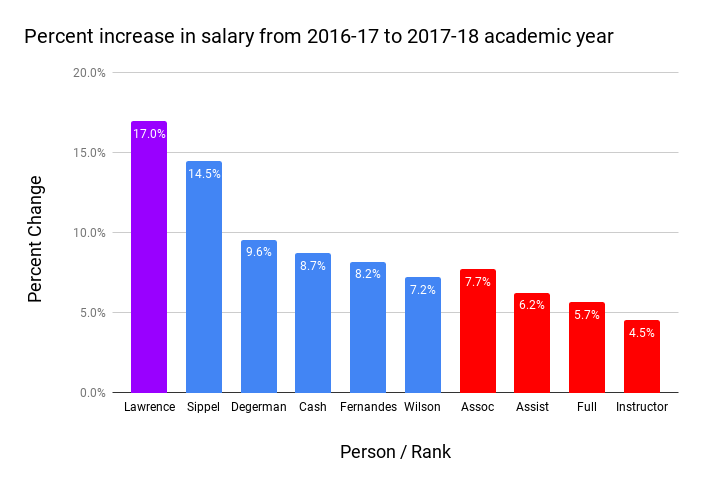I asked for Guilford’s most recent IRS Form 990. I do this for several reasons, but I got started with the 990’s after the administrator bonus fiasco at the end of the Chabotar administration in order to have a look at our reported compensation for administrators. This most recent report allowed me to track the impact of the January 2017 raises for some of our administrators. I’ve shown the raises below, compared with changes in faculty compensation as reported to the AAUP for the same years.

Data
Data sources for administrators are 2016-17 and 2017-18 Form 990’s, which cover our fiscal year. Because of a change in our fiscal year start date, the 2016-17 report only covered 11 months, so I prorated the salaries reported in that document to 12 months before calculating the raises.
Data sources for faculty are our average salary by rank for the academic years 2016-17 and 2017-18 as reported to the AAUP by the college.
The 2016-17 numbers include part of the period covered by the large January 2017 raises. I think those raises are included in the 990 reports, because those report total dollars. I am not sure if they are included in the AAUP faculty salary reports, but I don’t think they were, because they show very little change from 2015-16 numbers. If the January 2017 raises were included in the 2016-17 data for administrators and not for faculty, then the difference between faculty and administrators is even more stark, and the faculty raise percentages should be decreased by about half to make them comparable.
For the administrators, I only included people who were working for the full year in both years and whose income was reported on the 990 in both years, with two exceptions:
- Todd Clark, whose reported compensation dropped between the two years for reasons unknown to me, and
- Kent Chabotar, whose compensation was set at $100,000 for five years following his presidency under the terms of his initial presidential contract
Barbara Lawrence is a special case, because her position changed from faculty to VP between those two years, so the high raise percentage shown probably mostly represents her new position. Her faculty compensation was high enough (>$100K) to be reported on the 990 in the earlier year, likely in part because of her involvement in the prison education project.
Analysis and Notes
With the exception of Jimmy Wilson, all of the administrators listed received higher raises (by percentage) than all faculty ranks. Jimmy’s raise percent was higher than all faculty ranks except Associate.
In dollar terms, all of the raises were higher than average faculty raises, in some cases much higher. Administrator raises for those on this list ranged from about $8,000 to $26,000, while the faculty averages changed by $2,000 to $4,300.
Jane Fernandes’ salary is set by the board and is not included in the compensation plan. The board granted her a raise during this time.
If the compensation plan was applied appropriately to all of these individuals other than Jane, for whom the plan does not apply, this outcome (higher raises for administrators than faculty) is possible if the administrators listed were all farther behind their targets than the average faculty member. I don’t know if that is true, because I don’t know the targets used for administrators, but do we know the faculty are far below their targets, so the administrators would have to be even worse off. That doesn’t seem entirely likely, given that faculty were at or near the 20th percentile among peers. However, setting targets for administrative positions is tricky, because the administrative positions we have don’t necessarily equate to similar positions at other institutions.
The raises for faculty were affected by the bad data used to set targets, as I’ve discussed earlier this year. That error was likely not made for administrators. All faculty ranks were affected by the improperly low targets in the first round of raises in January 2017, included in these data. However, the effect of these low targets is not big enough to account for the full difference in raise percentages between faculty and administrators.
Some faculty members who were farther from their targets received larger percentage raises than those who were closer. For example, my personal percent raise during this period was 8.9%, higher than the full professor average and higher than some of the administrators.
There is the potential for an apples-to-oranges issue here, because the faculty percentages are based on groups of 20-30 people, while the administrator raises are individuals. However, assuming the faculty salaries are reported correctly, that should produce no significant systematic difference in the numbers, with the possible exception that retirements, departures, or promotions of many high-salary faculty at any rank could depress the average salary for that rank to some extent, though likely not too much. When looking at the numbers, remember that the individual faculty raises are a range centered around the percentages reported, and are probably on average a little higher than the reported figure due to retirements/departures.